Five Years of Accurate PM2.5 Measurements Demonstrate the Value of Low-Cost PurpleAir Monitors in Areas Affected by Woodsmoke
Abstract
1. Introduction
2. Materials and Methods
2.1. PA Data and Calibration Checks
2.2. Comparison with ALT-3.4
2.3. NSW Government Monitoring Sites at Gunnedah, Orange, and Muswellbrook
3. Results
3.1. Stability, Accuracy, and Spatial Variation in PurpleAir Measurements
3.2. PA vs. TEOM Measurements at Orange and Gunnedah
3.3. PA vs. BAM PM2.5 Measurements in Muswellbrook
3.4. Indoors vs. Outdoors
3.5. Comparison of 1-Day Averages at Selected Sites in Armidale, NSW, Canberra (ACT), and Christchurch (NZ)
4. Discussion
4.1. Accurate, Comprehensive Measurements with Minimal Calibration Drift
4.2. Potential to Consider Other Particle Sizes
4.3. Enhancing Estimates of Population Exposure, Costs, and Health Impacts
4.4. Application to Other Situations and Other Types of Low-Cost Sensors
5. Conclusions
Author Contributions
Funding
Institutional Review Board Statement
Informed Consent Statement
Data Availability Statement
Acknowledgments
Conflicts of Interest
Appendix A. Woodsmoke Pollution in Armidale, NSW
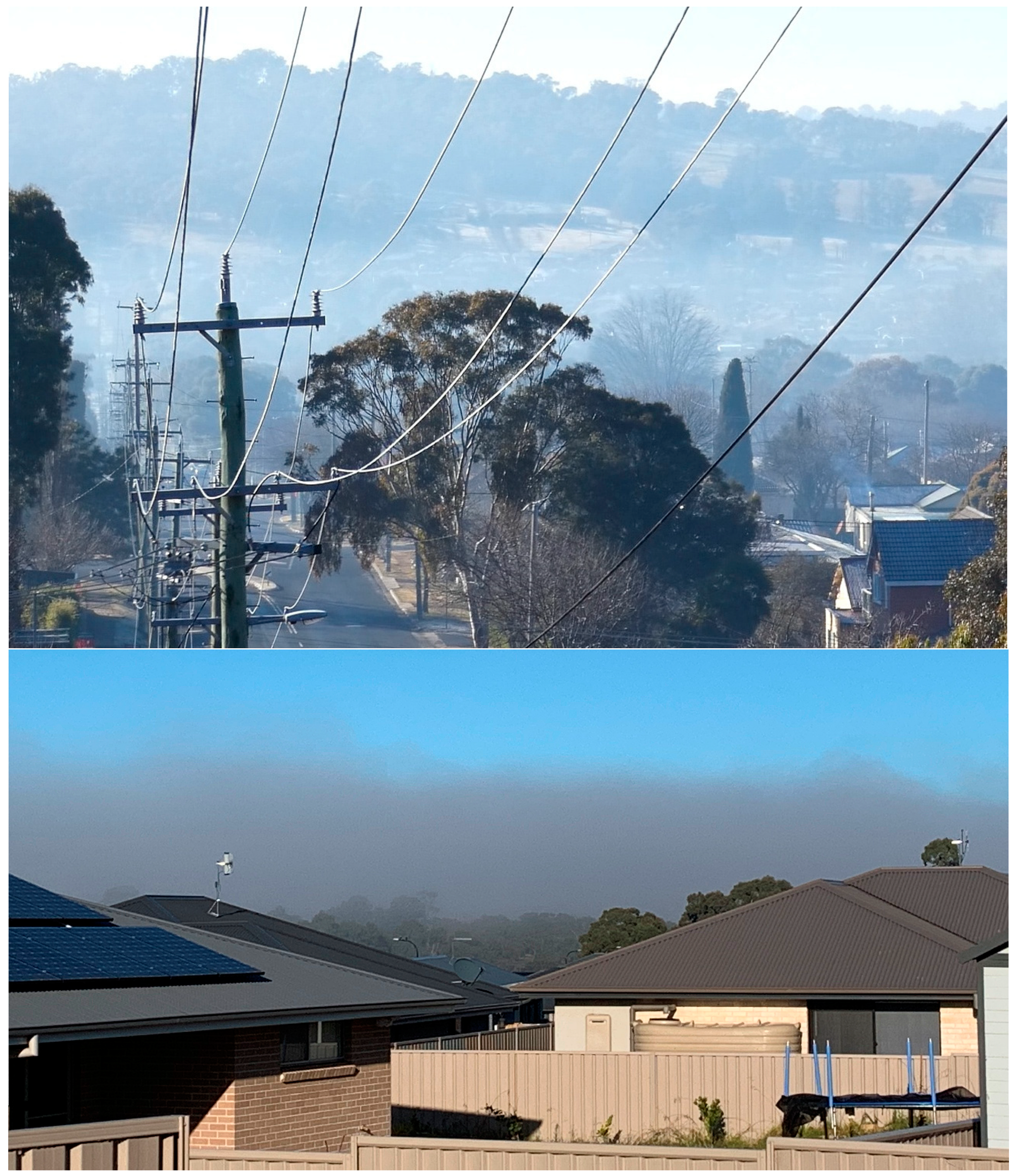
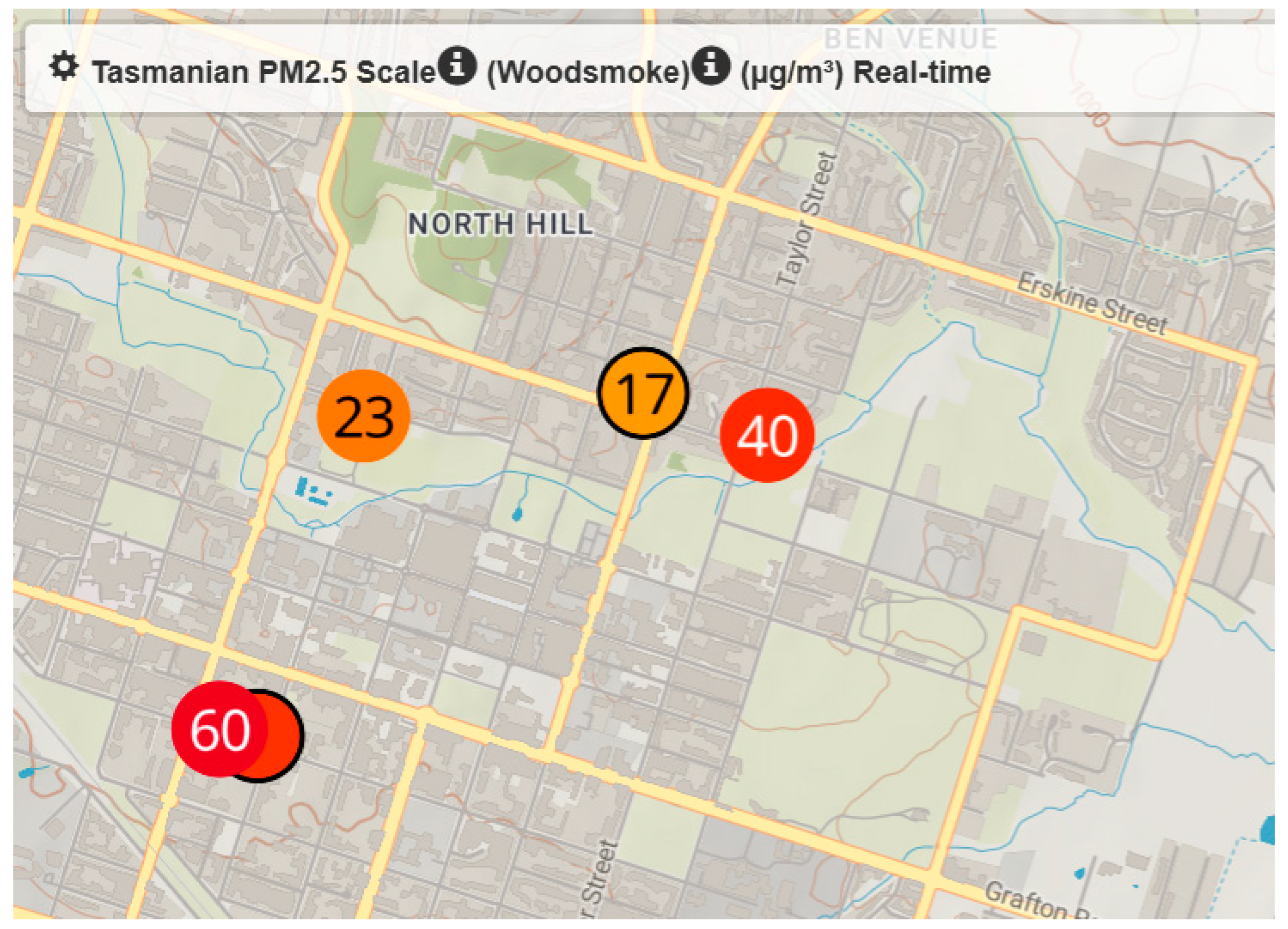
Appendix B. Benefits of Multiple Measurement Techniques and Locations to Assess Population Exposure
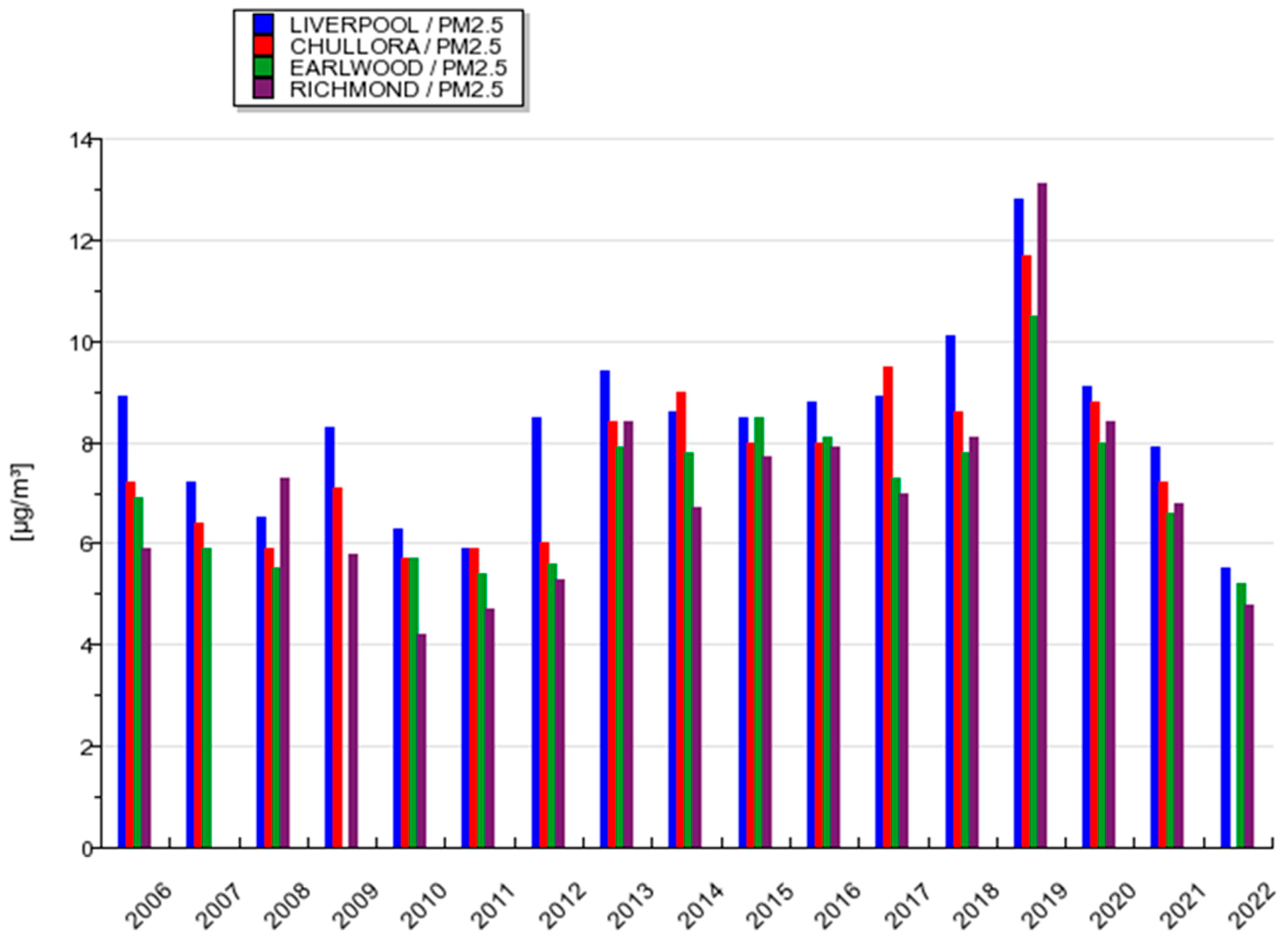
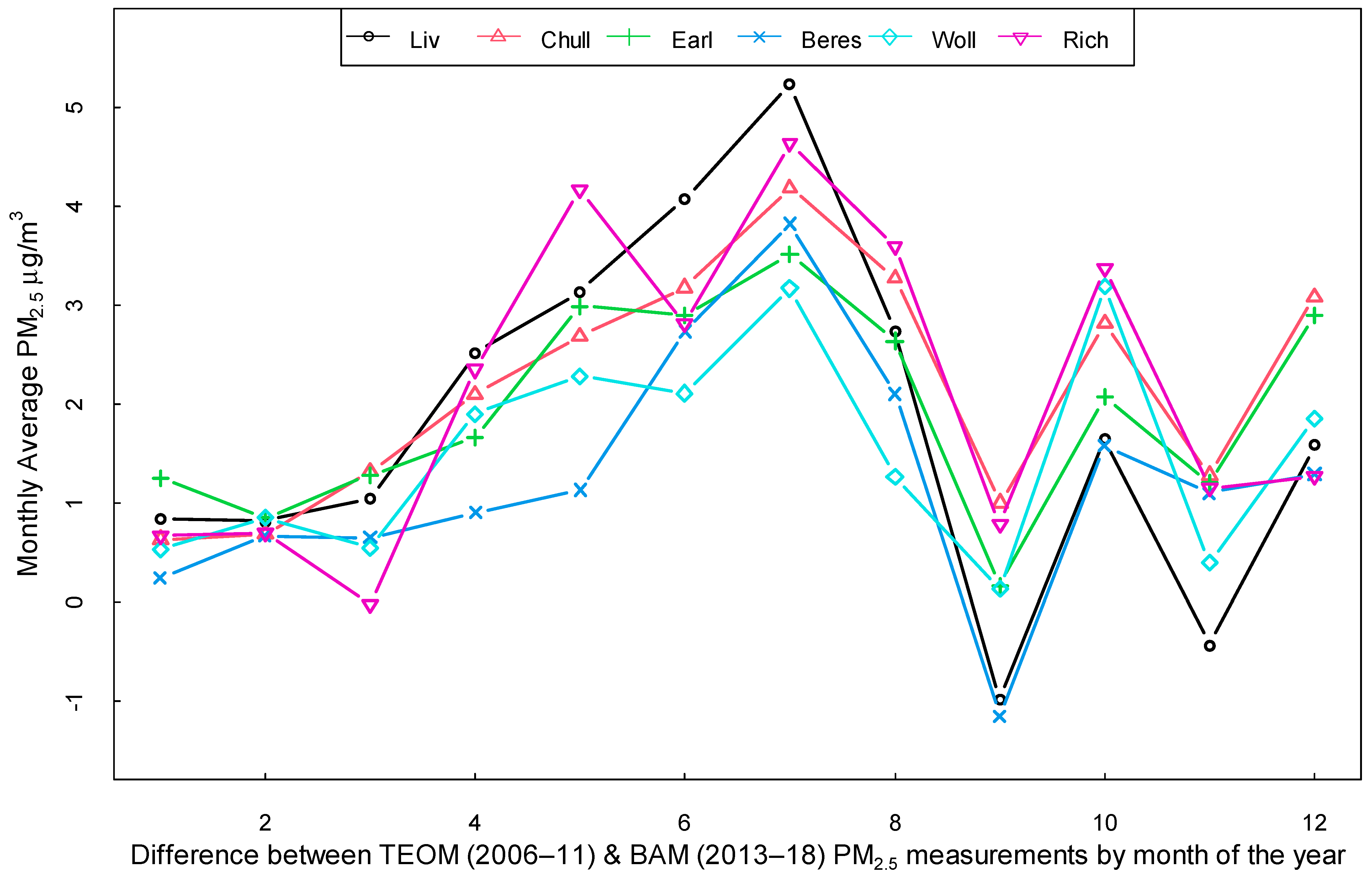
References
- Australian Government. National Environment Protection (Ambient Air Quality) Measure. Available online: https://www.legislation.gov.au/Details/F2016C00215 (accessed on 30 June 2023).
- Australian Government. Federal Register of Legislation. National Environment Protection (Ambient Air Quality) Measure. F2021c00475. 2021. Available online: https://www.Legislation.Gov.Au/Details/F2021c00475 (accessed on 11 November 2023).
- Lancet. GBD Cause and Risk Summaries. 2020. Available online: https://www.Thelancet.Com/Gbd/Summaries (accessed on 11 November 2023).
- EEA. Health Impacts of Air Pollution in Europe. 2022. Available online: https://www.eea.europa.eu/publications/air-quality-in-europe-2022/health-impacts-of-air-pollution (accessed on 2 August 2023).
- Thatcher, T.; Kirchstetter, T.; Tan, S.; Malejan, C.; Ward, C. Near-Field Variability of Residential Woodsmoke Concentrations. Atmos. Clim. Sci. 2014, 4, 622–635. [Google Scholar] [CrossRef][Green Version]
- Wagstaff, M. Monitoring Residential Woodsmoke in British Columbia Communities. MSc in Occupational and Environmental Hygiene. Master’s Thesis, University of British Columbia, Vancouver, BC, Canada, 2018. Available online: https://open.library.ubc.ca/cIRcle/collections/ubctheses/24/items/1.0371217 (accessed on 13 November 2023).
- Tunno, B.; Longley, I.; Somervell, E.; Edwards, S.; Olivares, G.; Gray, S.; Cambal, L.; Roper, C.; Coulson, G.; Chubb, L.; et al. Separating Spatial Patterns in Pollution Attributable to Woodsmoke and Other Sources, During Daytime and Nighttime Hours, in Christchurch, New Zealand. Environ. Res. 2019, 171, 228–238. [Google Scholar] [CrossRef] [PubMed]
- Innis, J.; Bell, A.; Cox, E.; Cunningham, A.; Hyde, B.; Smeal, A. Car-Based Surveys of Winter Smoke Concentrations in Some Tasmanian Towns, 2010–2012. In Proceedings of the 2013 Meeting of the Clean Air Society of Aus/Nz. EPA Division, DPIPWE, Sydney, Australia, 7–11 September 2013. [Google Scholar]
- Robinson, D.L.; Monro, J.M.; Campbell, E.A. Spatial Variability and Population Exposure to PM2.5 Pollution from Woodsmoke in a New South Wales Country Town. Atmos. Environ. 2007, 41, 5464–5478. [Google Scholar] [CrossRef]
- ABS. Armidale 2021. Census All Persons Quickstats. Available online: https://abs.gov.au/census/find-census-data/quickstats/2021/UCL112001 (accessed on 30 June 2023).
- Robinson, D.L. Accurate, Low Cost PM2.5 Measurements Demonstrate the Large Spatial Variation in Wood Smoke Pollution in Regional Australia and Improve Modeling and Estimates of Health Costs. Atmosphere 2020, 8, 856. [Google Scholar] [CrossRef]
- Wallace, L.; Zhao, T.; Klepeis, N.E. Calibration of Purpleair Pa-I and Pa-II Monitors Using Daily Mean PM2.5 Concentrations Measured in California, Washington, and Oregon from 2017 to 2021. Sensors 2022, 13, 4741. [Google Scholar] [CrossRef] [PubMed]
- Wallace, L.; Zhao, T. Spatial Variation of PM2.5 Indoors and Outdoors: Results from 261 Regulatory Monitors Compared to 14,000 Low-Cost Monitors in Three Western States over 4.7 Years. Sensors 2023, 9, 4387. [Google Scholar] [CrossRef] [PubMed]
- Johnson Barkjohn, K.; Holder, A.; Clements, A.; Frederick, S.; Evans, R. Sensor Data Cleaning and Correction: Application on the Airnow Fire and Smoke Map. In Proceedings of the American Association for Aerosol Research Conference; Albuquerque, NM, USA, 18–22 October 2021. Available online: https://cfpub.epa.gov/si/si_public_record_report.cfm?dirEntryId=353088&Lab=CEMM (accessed on 13 November 2023).
- Barkjohn, K.K.; Gantt, B.; Clements, A.L. Development and Application of a United States-Wide Correction for PM2.5 Data Collected with the Purpleair Sensor. Atmos. Meas. Tech. 2021, 6, 4617–4637. [Google Scholar] [CrossRef]
- Innis, J.; Cunningham, A.; Hyde, B.; Cox, E. Babyblanket: A Low-Cost, Highly-Portable, Realtime, Smoke-Monitoring Station Based on the Dylos Dc-1700 Laser Particle Counter. In Proceedings of the CASANZ 2015 Conference, Melbourne, Australia, 20–23 September 2015. [Google Scholar]
- Cagide, C. Purpleair’s 30,000 Citizen Scientists Across the World Give Communities Real-Time Information about the Air They Breathe. Available online: https://www.businesswire.com/news/home/20210921005311/en/PurpleAir%E2%80%99s-30000-Citizen-Scientists-Across-the-World-Give-Communities-Real-Time-Information-About-the-Air-They-Breathe (accessed on 30 June 2023).
- PurpleAir. Sensor Maintenance. Available online: https://community.purpleair.com/t/sensor-maintenance/1531 (accessed on 30 June 2023).
- Robinson, D.L.; Horsley, J.A.; Johnston, F.H.; Morgan, G.G. The Effects on Mortality and the Associated Financial Costs of Wood Heater Pollution in a Regional Australian City. Med. J. Aust. 2021, 215, 269–272. [Google Scholar] [CrossRef]
- NSW Government. Sydney Air Quality Study. Department of Planning and Environment, 2023. Available online: https://www.environment.nsw.gov.au/research-and-publications/publications-search/sydney-air-quality-study-program-report-stage-2 (accessed on 13 November 2023).
- Borchers-Arriagada, N.; Palmer, A.; Bowman, D.; Williamson, G.; Johnston, F. Health Impacts of Ambient Biomass Smoke in Tasmania, Australia. Int. J. Environ. Res. Public Health 2020, 9, 3264. [Google Scholar] [CrossRef]
- Kuschel, G.; Metcalfe, J.; Sridhar, S.; Davy, P.; Hastings, K.; Mason, K.; Denne, T.; Berentson-Shaw, J.; Bell, S.; Hales, S.; et al. Health and Air Pollution in New Zealand 2016 (Hapinz 3.0). Ministry for the Environment, Ministry of Health, Te Manatū Waka Ministry of Transport and Waka Kotahi Nz Transport Agency. March 2022. Available online: https://Environment.Govt.Nz/Publications/Health-and-Air-Pollution-in-New-Zealand-2016-Findings-and-Implications/ (accessed on 13 November 2023).
- Riley, M.; Kirkwood, J.; Jiang, N.; Ross, G.; Scorgie, Y. Air Quality Monitoring in Nsw: From Long Term Trend Monitoring to Integrated Urban Services. Air Qual. Clim. Change 2020, 1, 44–51. [Google Scholar]
- Rumpff, L.; Wintle, B.; Woinarski, J.; Legge, S.; Leeuwen, S.V. 200 Experts Dissected the Black Summer Bushfires in Unprecedented Detail. Here Are 6 Lessons to Heed. The Conversation. 2023. Available online: https://theconversation.com/200-experts-dissected-the-black-summer-bushfires-in-unprecedented-detail-here-are-6-lessons-to-heed-198989 (accessed on 13 November 2023).
- Robinson, D.L. Accounting for Bias in Regression Coefficients with Example from Feed Efficiency. Livest. Prod. Sci. 2005, 2, 155–161. [Google Scholar] [CrossRef]
- Balazer, J. Indoor Sensor Map Data Is Incorrect Due to Use of Cf=1 Sensor Values. Available online: https://community.purpleair.com/t/indoor-sensor-map-data-is-incorrect-due-to-use-of-cf-1-sensor-values/3021 (accessed on 30 June 2023).
- Wallace, L. Cracking the Code—Matching a Proprietary Algorithm for a Low-Cost Sensor Measuring PM1 and PM2.5. Sci. Total Environ. 2023, 893, 164874. [Google Scholar] [CrossRef] [PubMed]
- Kleeman, M.J.; Schauer, J.J.; Cass, G.R. Size and Composition Distribution of Fine Particulate Matter Emitted from Wood Burning, Meat Charbroiling, and Cigarettes. Environ. Sci. Technol. 1999, 20, 3516–3523. [Google Scholar] [CrossRef]
- NSW Government. Data Download Facility. Department of Planning and Environment, 2023. Available online: https://www.dpie.nsw.gov.au/air-quality/air-quality-data-services/data-download-facility (accessed on 13 November 2023).
- Hibberd, M.F.; Selleck, P.W.; Keywood, M.D.; Cohen, D.D.; Stelcer, E.; Atanacio, A.J. Upper Hunter Valley Particle Characterization Study; CSIRO: Canberra, Australia, 2013; ISBN 978-1-4863-0170-6. Available online: https://www.environment.nsw.gov.au/research-and-publications/publications-search/upper-hunter-valley-particle-characterization-study-final-report (accessed on 13 November 2023).
- Kleeman, M.J.; Schauer, J.J.; Cass, G.R. Size and Composition Distribution of Fine Particulate Matter Emitted from Motor Vehicles. Environ. Sci. Technol. 2000, 7, 1132–1142. [Google Scholar] [CrossRef]
- Jaffe, D.A.; Miller, C.; Thompson, K.; Finley, B.; Nelson, M.; Ouimette, J.; Andrews, E. An Evaluation of the U.S. Epa’s Correction Equation for Purpleair Sensor Data in Smoke, Dust, and Wintertime Urban Pollution Events. Atmos. Meas. Tech. 2023, 5, 1311–1322. [Google Scholar] [CrossRef]
- Lin, C.; Labzovskii, L.D.; Leung Mak, H.W.; Fung, J.C.H.; Lau, A.K.H.; Kenea, S.T.; Bilal, M.; Hey, J.D.V.; Lu, X.; Ma, J. Observation of PM2.5 Using a Combination of Satellite Remote Sensing and Low-Cost Sensor Network in Siberian Urban Areas with Limited Reference Monitoring. Atmos. Environ. 2020, 227, 117410. [Google Scholar] [CrossRef]
- Li, J.; Zhang, H.; Chao, C.-Y.; Chien, C.-H.; Wu, C.-Y.; Luo, C.H.; Chen, L.-J.; Biswas, P. Integrating Low-Cost Air Quality Sensor Networks with Fixed and Satellite Monitoring Systems to Study Ground-Level PM2.5. Atmos. Environ. 2020, 223, 117293. [Google Scholar] [CrossRef]
- Wheeler, A.; Reisen, F.; Roulston, C.; Dennekamp, M.; Goodman, N.; Johnston, F. Evaluating Portable Air Cleaner Effectiveness in Residential Settings to Reduce Exposures to Biomass Smoke Resulting from Prescribed Burns. Public Health Res. Pract. 2023, 33232307. [Google Scholar] [CrossRef]
- LAWA. Land Air Water Aotearoa. Air Quality Monitoring at St Albans, Christchurch. Available online: https://www.lawa.org.nz/explore-data/canterbury-region/air-quality/christchurch/st-albans-ep (accessed on 30 June 2023).
- Collier-Oxandale, A.; Feenstra, B.; Papapostolou, V.; Polidori, A. Airsensor V1.0: Enhancements to the Open-Source R Package to Enable Deep Understanding of the Long-Term Performance and Reliability of Purpleair Sensors. Environ. Model. Softw. 2022, 148, 105256. [Google Scholar] [CrossRef]
- DEH. Department of Environment and Heritage. Use of Particle Counters in Woodsmoke Affected Areas. 2005. Available online: https://web.archive.org/web/20060831044828/http://www.deh.gov.au/atmosphere/airquality/publications/pubs/particle-counters.pdf (accessed on 13 November 2023).
- Innis, J.L. Blanket Technical Report 31. Overview of the Blanket Smoke Monitoring Network: Development and Operation, 2009–2015. Air Section, EPA Division, November 2015. Available online: https://epa.tas.gov.au/environment/air/monitoring-air-pollution/monitoring-data/reports-and-historical-data/blanket-reports (accessed on 11 November 2023).
- Innis, J. One House, Two Neighbouring Chimneys, Six Sensors. In Air Talks; CASANZ: Melbourne, Australia, 2022. [Google Scholar]
- Parliament of NSW. 5132-Energy and Environment-Health-Hazardous Air Pollution from Wood-Fired Heaters. Answer to Parliamentary Question. Legislative Council, 2021. Available online: https://www.parliament.nsw.gov.au/lc/papers/pages/qanda-tracking-details.aspx?pk=81802 (accessed on 8 September 2023).
- SCAQMD. Field Evaluation Purple Air PM Sensor. South Coast Air Quality Management District, 2017. Available online: https://web.archive.org/web/20220906155233/http://www.aqmd.gov/docs/default-source/aq-spec/field-evaluations/purpleair---field-evaluation.pdf (accessed on 13 November 2023).
- Zheng, M.; Yin, Z.; Wei, J.; Yu, Y.; Wang, K.; Yuan, Y.; Wang, Y.; Zhang, L.; Wang, F.; Zhang, Y. Submicron Particle Exposure and Stroke Hospitalization: An Individual-Level Case-Crossover Study in Guangzhou, China, 2014–2018. Sci. Total Environ. 2023, 886, 163988. [Google Scholar] [CrossRef]
- Chen, G.; Jin, Z.; Li, S.; Jin, X.; Tong, S.; Liu, S.; Yang, Y.; Huang, H.; Guo, Y. Early Life Exposure to Particulate Matter Air Pollution (PM1, PM2.5 and PM10) and Autism in Shanghai, China: A Case-Control Study. Environ. Int. 2018, 121, 1121–1127. [Google Scholar] [CrossRef] [PubMed]
- Yang, M.; Guo, Y.-M.; Bloom, M.S.; Dharmagee, S.C.; Morawska, L.; Heinrich, J.; Jalaludin, B.; Markevychd, I.; Knibbsf, L.D.; Lin, S.; et al. Is PM1 Similar to PM2.5? A New Insight into the Association of PM1 and PM2.5 with Children’s Lung Function. Environ. Int. 2020, 145, 106092. [Google Scholar] [CrossRef] [PubMed]
- Zong, Z.; Zhao, M.; Zhang, M.; Xu, K.; Zhang, Y.; Zhang, X.; Hu, C. Association between PM1 Exposure and Lung Function in Children and Adolescents: A Systematic Review and Meta-Analysis. Int. J. Environ. Res. Public Health 2022, 23, 15888. [Google Scholar] [CrossRef] [PubMed]
- Zhang, Y.; Ding, Z.; Xiang, Q.; Wang, W.; Huang, L.; Mao, F. Short-Term Effects of Ambient PM1 and PM2.5 Air Pollution on Hospital Admission for Respiratory Diseases: Case-Crossover Evidence from Shenzhen, China. Int. J. Hyg. Environ. Health 2020, 224, 113418. [Google Scholar] [CrossRef]
- Kulshrestha, U.C. PM1 Is More Important Than PM2.5 for Human Health Protection. Curr. World Environ. 2018, 13. [Google Scholar] [CrossRef]
- Mitchell, T. Masterton Winter Woodsmoke Survey, 2018. Greater Wellington Regional Council, Publication No. GW/ESCI-T-18/167, Wellington. 2019. Available online: https://www.gwrc.govt.nz/assets/Documents/2019/03/Masterton-winter-wood-smoke-survey-2018-.pdf (accessed on 13 November 2023).
- Innis, J. Localised and Highly-Degraded Air Quality in Winter: ‘Flue-Season’ in Tasmania; CASANZ: Melbourne, Australia, 2021. [Google Scholar]
- Broome, R.A.; Powell, J.; Cope, M.E.; Morgan, G.G. The Mortality Effect of PM2.5 Sources in the Greater Metropolitan Region of Sydney, Australia. Environ. Int. 2020, 137, 105429. [Google Scholar] [CrossRef] [PubMed]
- Liang, L.; Daniels, J.; Bailey, C.; Hu, L.; Phillips, R.; South, J. Integrating Low-Cost Sensor Monitoring, Satellite Mapping, and Geospatial Artificial Intelligence for Intra-Urban Air Pollution Predictions. Environ. Pollut. 2023, 331, 121832. [Google Scholar] [CrossRef]
- Cukjati, J.; Mongus, D.; Žalik, K.R.; Žalik, B. Iot and Satellite Sensor Data Integration for Assessment of Environmental Variables: A Case Study on No2. Sensors 2022, 15, 5660. [Google Scholar] [CrossRef]
- Hales, S.; Atkinson, J.; Metcalfe, J.; Kuschel, G.; Woodward, A. Long Term Exposure to Air Pollution, Mortality and Morbidity in New Zealand: Cohort Study. Sci. Total Environ. 2021, 801, 149660. [Google Scholar] [CrossRef]
- WHO. Review of Evidence on Health Aspects of Air Pollution–Revihaap. 2013. Available online: https://iris.who.int/bitstream/handle/10665/341712/WHO-EURO-2013-4101-43860-61757-eng.pdf (accessed on 13 November 2023).
- Vardoulakis, S.; Jalaludin, B.B.; Morgan, G.G.; Hanigan, I.C.; Johnston, F.H. Bushfire Smoke: Urgent Need for a National Health Protection Strategy. Med. J. Aust. 2020, 8, 349–353. [Google Scholar] [CrossRef]
- R Core Team. R: A Language and Environment for Statistical Computing; R Foundation for Statistical Computing: Vienna, Austria, 2023; Available online: https://www.R-project.org/ (accessed on 13 November 2023).
- Innis, J. Blanket Technical Report–1. A General Description of the Blanket Project (Base-Line Air Network of Epa Tasmania)—Aims, Methodology, and First Results; EPA: Hobart, Tasmania, 2009. [Google Scholar]
- Meyer, M.B.; Lijek, J.; Ono, D. Continuous PM10 Measurements in a Woodsmoke Environment. In PM10 Standards and Nontraditional Particulate Source Controls; Chow, J.C., Ono, D.M., Eds.; Air & Waste Management Association: Pittsburg, PA, USA, 1992. [Google Scholar]
- Department of Environment Climate Change and Water NSW. New South Wales Annual Compliance Report 2008. Available online: www.nepc.gov.au/sites/default/files/2022-09/aaq-mntrpt-2008-nsw-report-final-0.pdf (accessed on 13 November 2023).
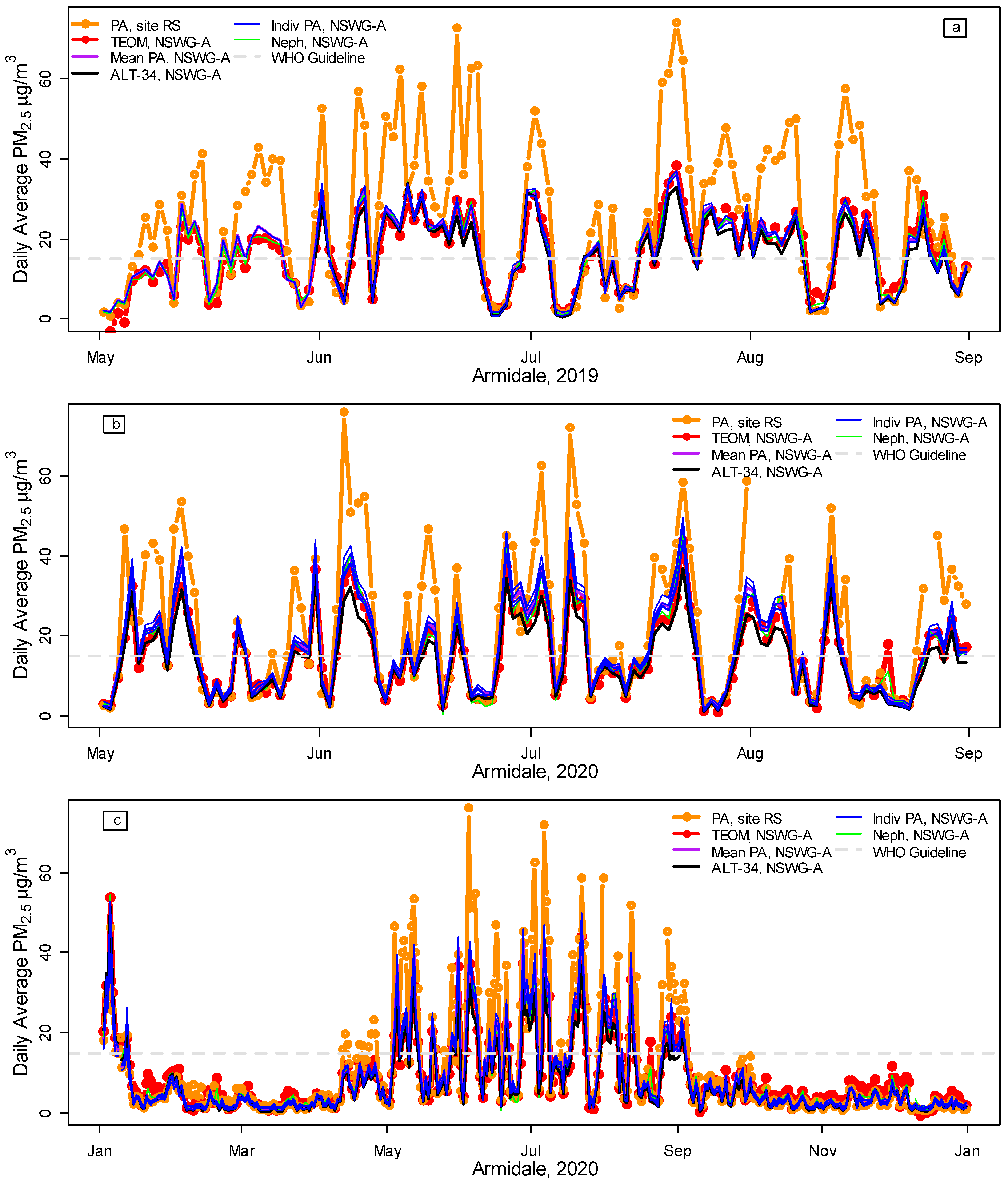
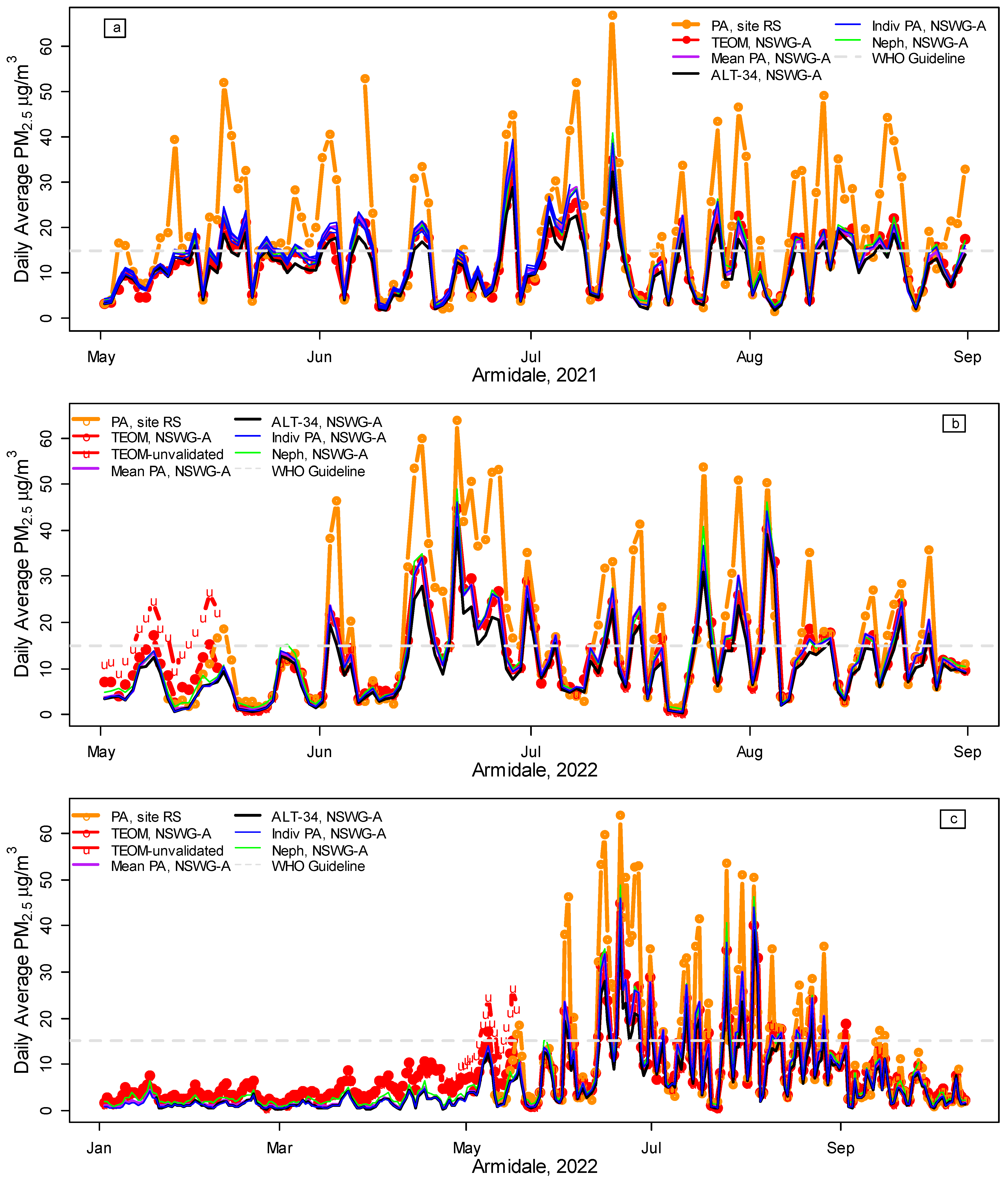
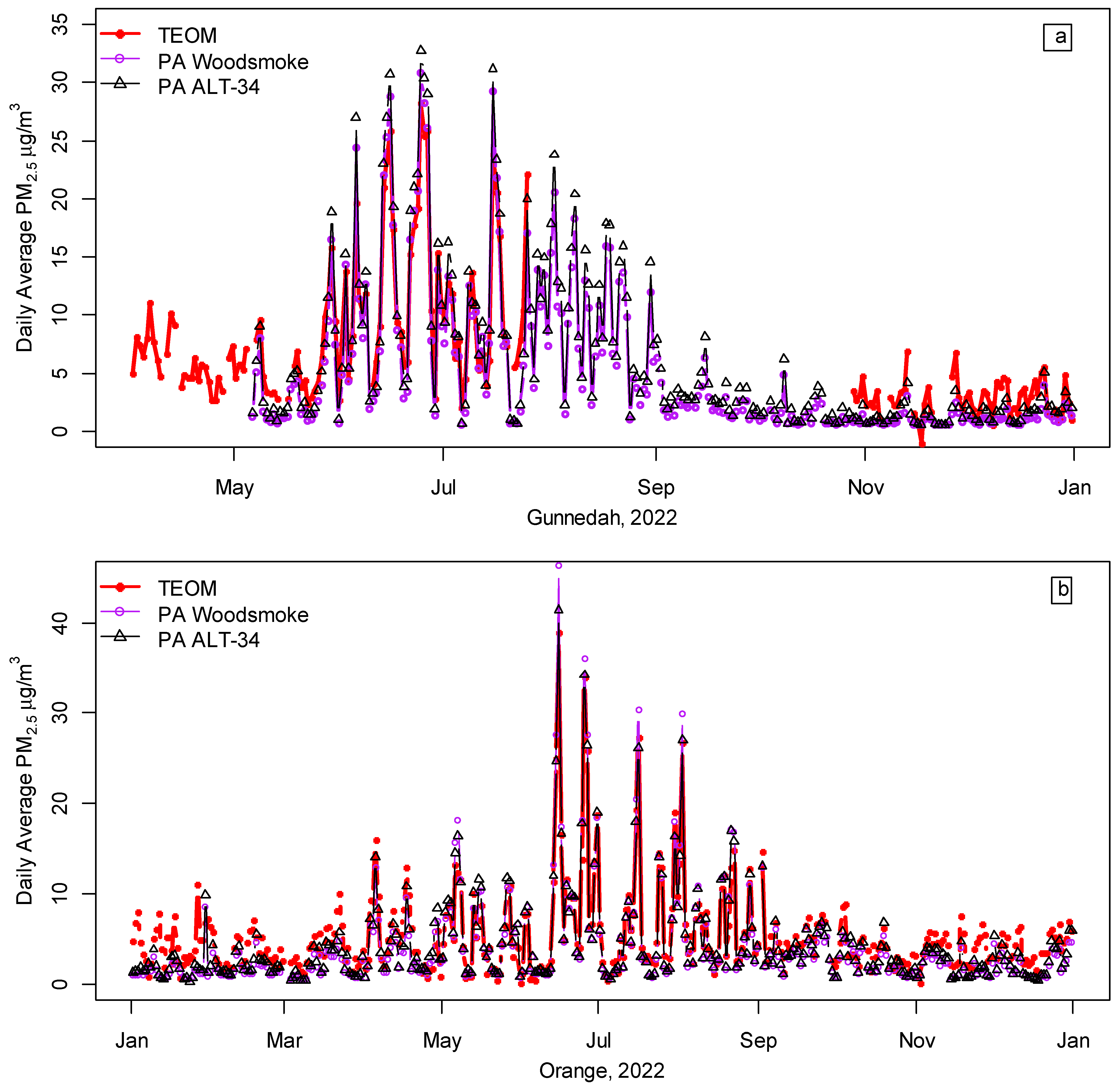
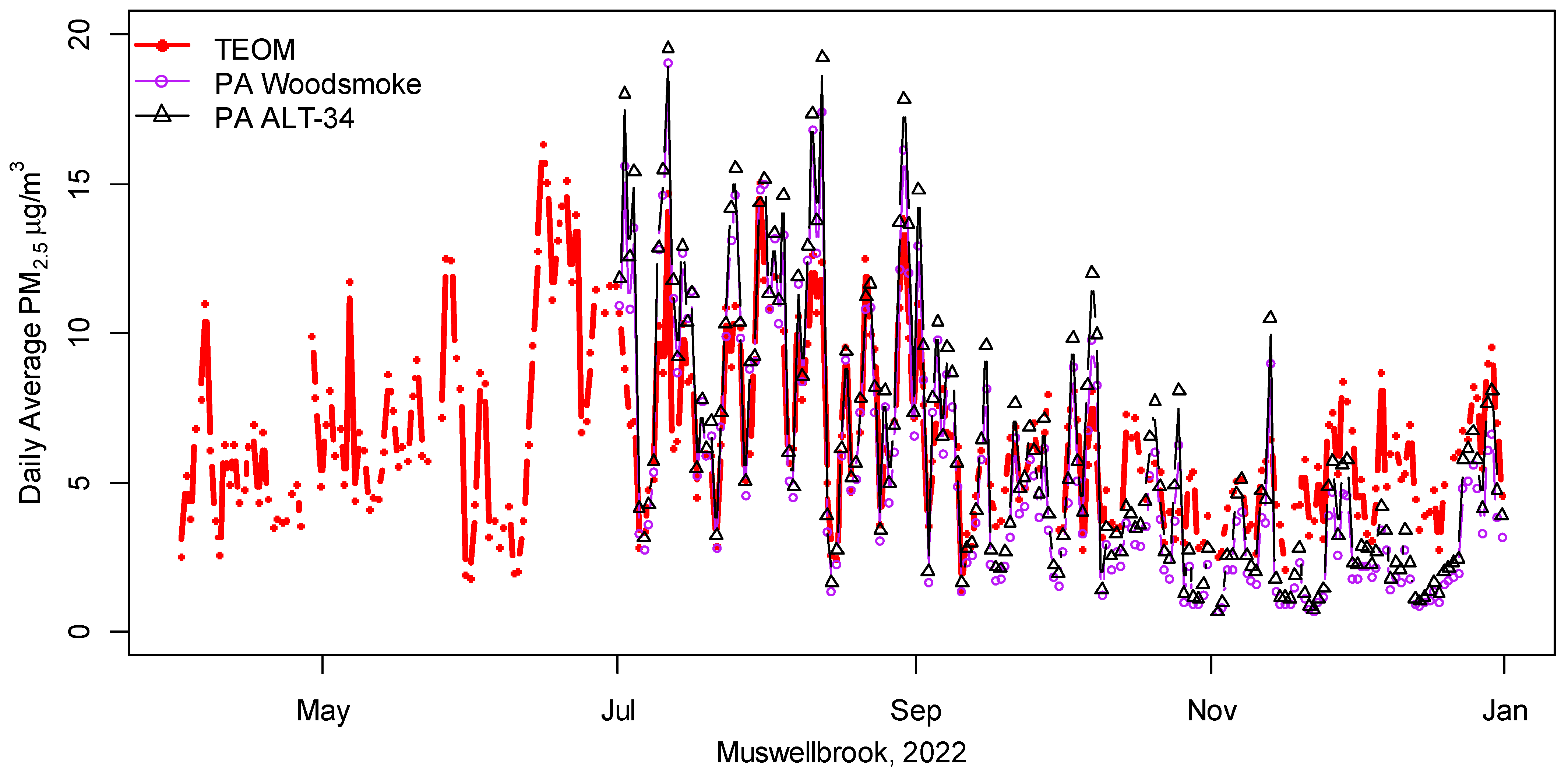
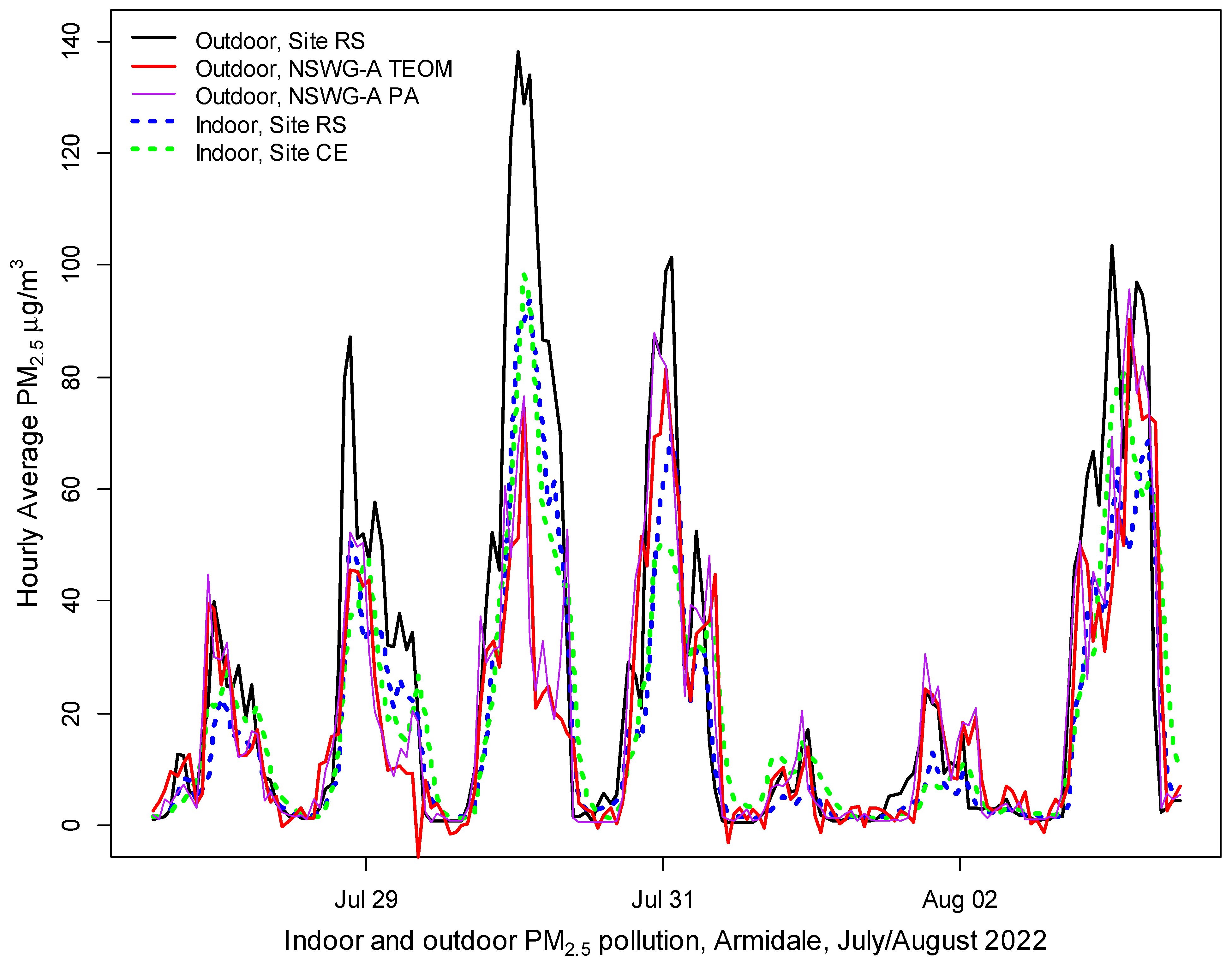
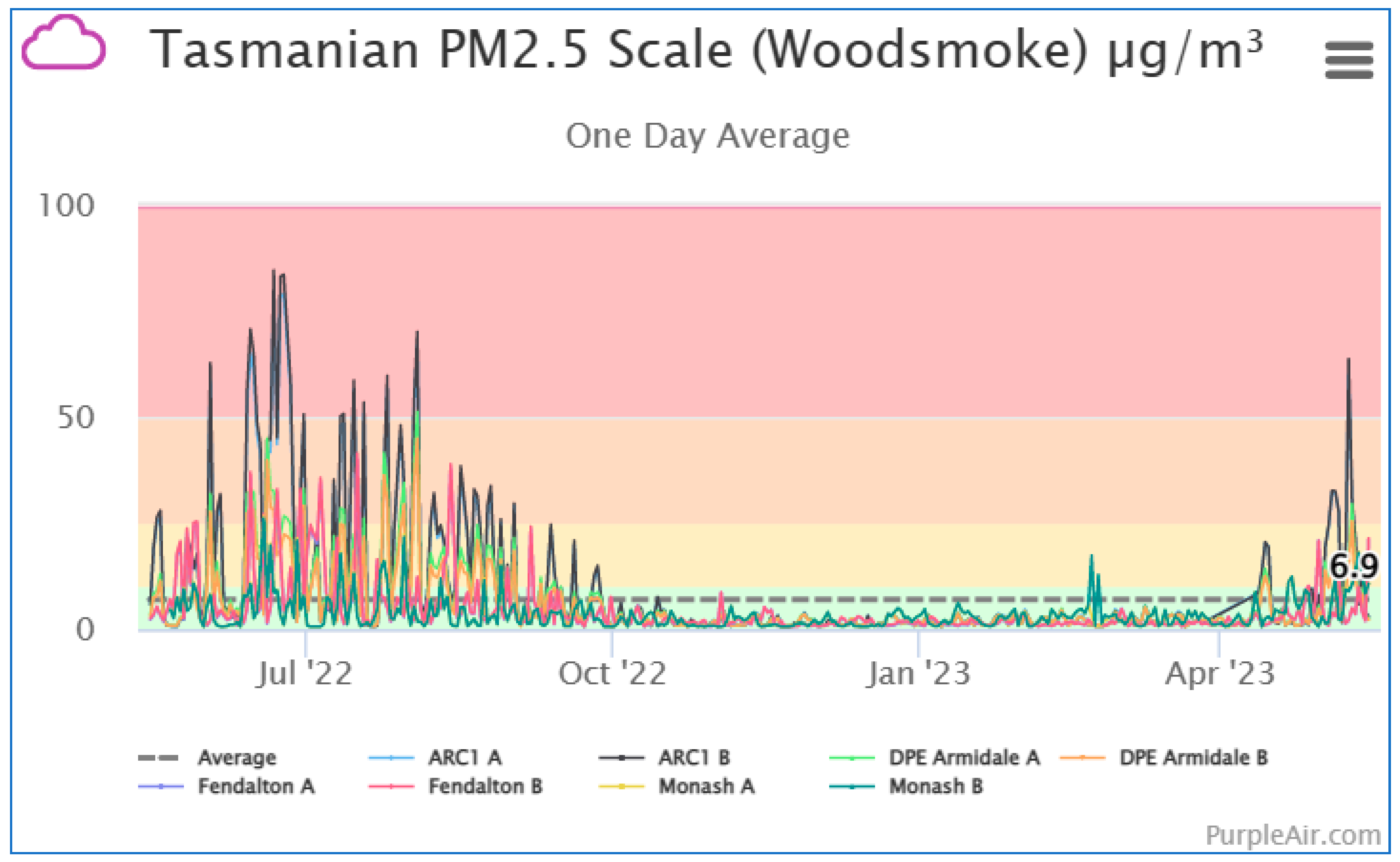
| PurpleAir Unit 1 | Dates at NSWG-A | Dates at RS, RSi, RE and RCEi 2 | Calibration, 2018 3 |
|---|---|---|---|
| DPE, 29949 | 31 May 2019 onwards | 0.53, 0.55 (D) | |
| ARC2, 10476 | 1 January 2019–7 July 2021 | RSi: from 7 July 2021 | 1.41, 0.524 |
| ARC1, 10452 | 24 August 2019–7 July 2021 | RE: from 20 July 2021 | 1.15, 0.516 |
| ARC02, 10472 | 7 July 2021–27 July 2021 | RSi: until 7 July 2021 | 0.53, 0.55 (D) |
| ARC17, 10140 | 27 July 2021–27 May 2022 | RCEi: from 17 June 2022 | 1.66, 0.523 |
| Arm1, 1732 | 1 January 2019–7 July 2021 | RS: from 7 July 2021 | 0.53, 0.580 |
| Arm2, 1738 | 7 August 2021–22 May 2022 | 0.53, 0.510 | |
| Arm3, 1720 | 7 July 2021–7 August 2021 | RS: 1 January 2019–7 July 2021 | 0.53, 0.596 |
| Comparison Period | PA Calibration/Conversion | Correlation (r ± SE), PA vs. TEOM | RMSE 1 | Days Compared | RMA Slope | OLS Regression 2 | Mean TEOM | Mean PA | |
|---|---|---|---|---|---|---|---|---|---|
| Slope | Intercept | ||||||||
| Armidale, 31 May 2019 to 12 Oct 2022 3 | |||||||||
| April–September | woodsmoke | 0.98 ± 0.01 | 2.09 | 608 | 0.92 | 0.90 | 1.29 | 13.16 | 13.24 |
| PA-ALT-34 | 0.98 ± 0.01 | 2.47 | 608 | 1.06 | 1.04 | 1.18 | 13.16 | 11.56 | |
| All valid data in all years | woodsmoke | 0.98 ± 0.01 | 2.03 | 980 | 0.91 | 0.90 | 1.41 | 9.90 | 9.48 |
| PA-ALT-34 | 0.98 ± 0.01 | 2.31 | 980 | 1.03 | 1.01 | 1.44 | 9.90 | 8.35 | |
| June–August 2022 | woodsmoke | 0.99 ± 0.02 | 1.41 | 92 | 0.95 | 0.94 | 0.85 | 14.45 | 14.47 |
| PA-ALT-34 | 0.99 ± 0.02 | 2.69 | 92 | 1.12 | 1.11 | 0.75 | 14.45 | 12.35 | |
| Orange, 2022 | |||||||||
| April–September | woodsmoke | 0.97 ± 0.02 | 1.74 | 176 | 0.88 | 0.86 | 1.27 | 6.57 | 6.17 |
| PA-ALT-34 | 0.98 ± 0.02 | 1.40 | 176 | 0.96 | 0.94 | 0.66 | 6.57 | 6.30 | |
| All year | woodsmoke | 0.94 ± 0.02 | 2.22 | 352 | 0.87 | 0.82 | 1.98 | 5.28 | 4.02 |
| PA-ALT-34 | 0.94 ± 0.02 | 1.91 | 352 | 0.93 | 0.88 | 1.49 | 5.28 | 4.29 | |
| Gunnedah, 2022 | |||||||||
| April–September | woodsmoke | 0.98 ± 0.03 | 2.41 | 75 | 0.82 | 0.80 | 2.85 | 10.14 | 9.12 |
| PA-ALT-34 | 0.98 ± 0.03 | 2.58 | 75 | 0.77 | 0.75 | 2.38 | 10.14 | 10.32 | |
| All year | woodsmoke | 0.94 ± 0.03 | 3.33 | 189 | 0.83 | 0.78 | 3.31 | 6.74 | 4.42 |
| PA-ALT-34 | 0.94 ± 0.03 | 2.97 | 189 | 0.78 | 0.73 | 2.86 | 6.74 | 5.32 | |
Disclaimer/Publisher’s Note: The statements, opinions and data contained in all publications are solely those of the individual author(s) and contributor(s) and not of MDPI and/or the editor(s). MDPI and/or the editor(s) disclaim responsibility for any injury to people or property resulting from any ideas, methods, instructions or products referred to in the content. |
© 2023 by the authors. Licensee MDPI, Basel, Switzerland. This article is an open access article distributed under the terms and conditions of the Creative Commons Attribution (CC BY) license (https://creativecommons.org/licenses/by/4.0/).
Share and Cite
Robinson, D.L.; Goodman, N.; Vardoulakis, S. Five Years of Accurate PM2.5 Measurements Demonstrate the Value of Low-Cost PurpleAir Monitors in Areas Affected by Woodsmoke. Int. J. Environ. Res. Public Health 2023, 20, 7127. https://doi.org/10.3390/ijerph20237127
Robinson DL, Goodman N, Vardoulakis S. Five Years of Accurate PM2.5 Measurements Demonstrate the Value of Low-Cost PurpleAir Monitors in Areas Affected by Woodsmoke. International Journal of Environmental Research and Public Health. 2023; 20(23):7127. https://doi.org/10.3390/ijerph20237127
Chicago/Turabian StyleRobinson, Dorothy L., Nigel Goodman, and Sotiris Vardoulakis. 2023. "Five Years of Accurate PM2.5 Measurements Demonstrate the Value of Low-Cost PurpleAir Monitors in Areas Affected by Woodsmoke" International Journal of Environmental Research and Public Health 20, no. 23: 7127. https://doi.org/10.3390/ijerph20237127
APA StyleRobinson, D. L., Goodman, N., & Vardoulakis, S. (2023). Five Years of Accurate PM2.5 Measurements Demonstrate the Value of Low-Cost PurpleAir Monitors in Areas Affected by Woodsmoke. International Journal of Environmental Research and Public Health, 20(23), 7127. https://doi.org/10.3390/ijerph20237127








